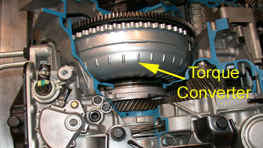
Description: The torque converter portion has the ability to multiply torque from the engine. The impeller (sometimes called the pump) has specially curved vanes and is driven by the engine's crankshaft. The turbine also has specially curved vanes and is connected to the input shaft of the transmission. Adding a third element, the stator (also called the reactor), gives the assembly the capability it's named for. The stator has vanes and is mounted on a one-way clutch, to allow it to freewheel in only one direction. The stator assembly is located between the impeller and turbine and redirects oil that bounces back off the turbine. The force of the redirected oil assists in rotating the turbine, resulting in torque multiplication. When the impeller's speed is high and turbine's speed is low, torque can be multiplied by as much as 2:1. When the impeller's speed and the turbine's speed are about the same, torque can be transferred at almost 1:1. Carmakers took the torque converter one step further by adding a lock-up function beginning around 1980. Lock-up converters also contain a friction clutch that locks the converter impeller to the turbine, usually in higher gears. A solenoid-controlled oil passage, commanded by the car’s powertrain control module (PCM), locks and unlocks the converter based on driving conditions.
Purpose: The torque converter, connected to the transmission/transaxle input shaft, connects, multiplies and interrupts the flow of engine torque into the transmission. The torque converter supplies torque to the transmission's input shaft in two separate, distinct ways: hydraulic input and mechanical input (lock-up converters only). Hydraulic input comes from the torque converters turbine and the amount of input torque can vary depending on the operating conditions within the converter. Mechanical input results when the lock-up function of the converter engages. The end result is better fuel economy because all converter slippage is eliminated when the converter locks. The torque converter also helps to smooth out engine power pulses, as does the flywheel on a car with a manual transmission.
Maintenance Tips/Suggestions: The torque converter does not require any regular maintenance or adjustments, but it may be possible to change the transmission fluid in the converter through draining (if equipped with a drain) or with a transmission flushing and filling machine. Much of the transmission’s fluid stays in the converter and since the converter produces a tremendous amount of heat (the enemy of transmission fluid) there’s good reason to change it if possible. Torque converter problems fall into two categories: 1) problems within the torque converter itself, or 2) problems within the torque converter clutch. If you suspect a problem with the converter or transmission, have it evaluated by a qualified transmission specialist. With the complexity of today’s transmissions and torque converters, there’s no room for guesswork.

